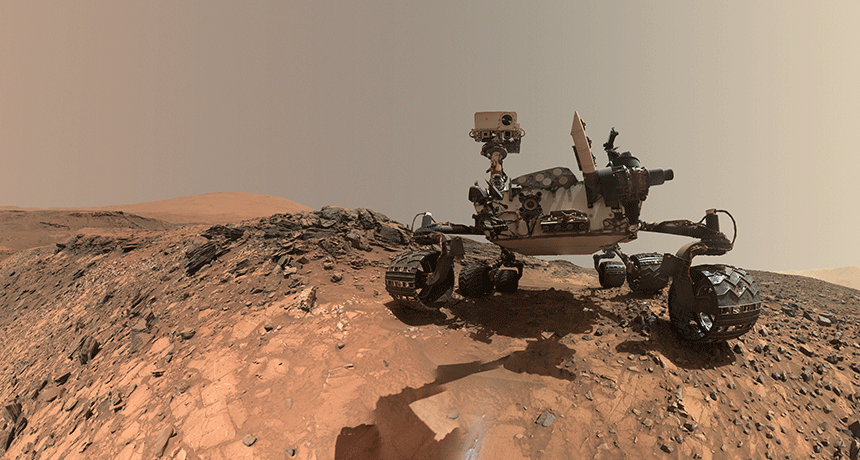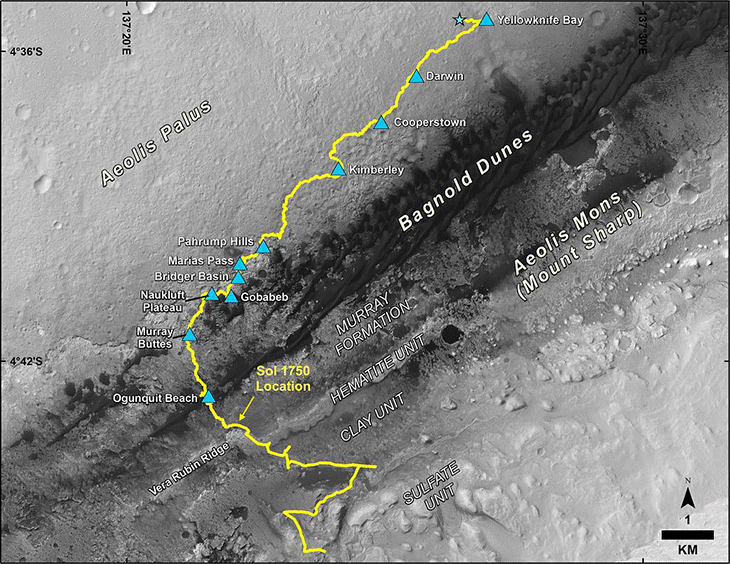What the Curiosity rover has learned about Mars so far
While it has found no signs of life, its cameras and other tools have spied hints of water and habitable soils

Curiosity has done a lot more than take selfies in front of Gale Crater, and with its mission extended through next fall, there’s still more science to come.
MSSS, JPL-Caltech/NASA
August 5 marks the fifth anniversary of the Curiosity rover’s 2012 landing on Mars. The little robot is by now an old pro at doing science on the Red Planet. And this Little Robot That Could has learned a lot.
Its mission had been simple. It was to look for signs that the planet might once have been habitable — for microbes, not for Matt Damon! To do that, NASA sent the robot to Gale Crater. It’s a huge impact basin with a mountain at its center. Curiosity has traveled across the crater, turning over rocks. Along the way, the robot collected evidence of ancient water, minerals, organic chemicals and other materials needed for life.
Curiosity was so successful that NASA has extended its mission through October 2018. After all, there’s still plenty of interesting chemistry and geology to be done. As the robot continues to climb Mount Sharp at the center of the crater, it will explore three new rock layers. One is dominated by an iron mineral known as hematite (HE-mah-tyte). Another layer is mostly clay. The third contains plenty of sulfate-based salts.
What more could Curiosity dig up over the next year? Here are four mysteries it might solve (or at least find more clues to).
(Story continues after video)
MSSS, JPL-Caltech/NASA
Are there remains of ancient life in the Martian soil?
Any signs of life would likely be microbial. Curiosity can take images of very tiny things with a tool known as the Mars Hand Lens Imager. To succeed at finding microfossils, however, those ancient cells would still have to be pretty big. What the rover might do instead is scan for the chemicals used to build such cells. And Curiosity can try that using its portable chemistry lab known as SAM (for Sample Analysis at Mars).
So far, SAM already has found a small organic molecule, meaning one with carbon in it. This ring-shaped chemical — chlorobenzene — turned up in ancient mud rock. Its discovery excited scientists. After all, chains of such molecules go into making things such as cell walls.
“We’ve only found simple organic molecules so far,” says Ashwin Vasavada. He works at NASA’s Jet Propulsion Laboratory (JPL) in Pasadena, Calif. There, this planetary scientist heads Curiosity’s science team. Detective work in chemistry labs on Earth might point to whether bigger organic chemicals might degrade on Mars’ surface into smaller ones, such as chlorobenzene.
Curiosity might still turn up bigger molecules made from chains of carbon. The rover carries two sets of cups to do chemistry experiments. A set of dry cups contains chemicals that could draw out hard-to-find organic compounds. There are also “wet” cups. None of these have been used, so far. A December 2016 problem with Curiosity’s drill put the rover’s search for organics on temporary hold. Possible solutions are, however, in the works, NASA says.
How did Mars morph from wet and warm to cold and dry?
Studies have pointed to there once having been water on Mars. In fact, Gale crater once held a lake fed by rivers. Moreover, Curiosity’s very first drilling sample detected chemicals that can form only in nonacidic environments that would comfortable for Earth-type life. Among those chemicals was calcium sulfate. The rocks also contained clays. These would have formed in water — and only water that was slightly salty.
Scientists with NASA have concluded that the Martian soil seems the most hospitable environment ever detected outside Earth.
But things didn’t stay potentially cozy. Some 3.5 billion years ago, things changed.
The going theory is that when Mars lost its protective magnetic field, particles from the sun began stripping away some of the Red Planet’s atmosphere. (By the way, its atmosphere continues to erode today.) “That caused the climate to change from one that could support water at the surface to the dry planet it is today,” explains Vasavada.
Curiosity has turned up a relatively high proportion of heavy elements in the Martian atmosphere. This supports the idea that lighter elements were once there but simply proved the first to go.
There’s also a chance that as the rover hikes up Mount Sharp, it could capture regional evidence of the wet-to-dry transition in action. So far, Curiosity has investigated rocks from the end of the wet period. They pointed to the planet once having hosted surface lakes that lasted for millennia!
Rocky sites the rover is now approaching are younger. “Hopefully we’ll be able to get some insight by looking at these rocks into some of the global changes happening,” says Abigail Fraeman. She’s a research scientist at JPL. Probing rock at the new sites might help uncover what types of changes made surface lakes a thing of the past.

Does Mars really have flowing water today?
Some mineral salts absorb water, then later release it as a liquid when they break down. The Curiosity team looked for the bursts of water that might result from such a process in Gale Crater. And it came up empty.
Two years ago, the Mars Reconnaissance Orbiter snapped images of shifting salt streaks. Those suggested Mars once had actively flowing water. These photos are the best evidence yet that Mars’ liquid water might not be gone forever.
Mount Sharp also has such dark streaks. Curiosity takes pictures of them now and again. “It’s something we keep an eye on,” Vasavada says. If the streaks change in a way that might indicate that they’re moving, the rover might drive over to look for water. Alas, so far the streaks have not changed.
What’s the source of methane in Mars’ atmosphere?
On Earth, microbes are big producers of methane gas. There is methane in the Martian air, too. But where it comes from is unclear. Atmospheric methane levels appear to vary over the course of a year. Changing temperatures or pressure might be behind these subtle fluctuations. Curiosity will continue to monitor methane levels. It also will collect more data, hoping to help pinpoint what’s behind the annual ups and downs.
At the end of 2014, scientists detected a 10-fold spike in the methane in Mars’ atmosphere. They now suspect that methane remains in the Martian air for only about 300 years. So, it’s a relatively new addition. “That doesn’t necessarily mean it’s being actively created,” Vasavada says. “It could be old methane being released from underground.” (As minerals interact with water underground, they sometimes help create methane gas.) Mars’ methane also might be the product of planetary dust particles as they break down on the planet’s surface.
Another possible explanation: Life! “We have zero information to know whether that’s happening on Mars, but we shouldn’t exclude [life] as an idea,” says Vasavada of methane-making microbes. Martian life is unlikely, he says, but it cannot be completely ruled out.







